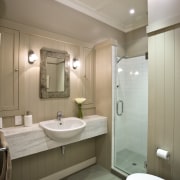Country chic
This renovation of a 1930s stucco cottage has opened up the interior to provide a spacious, character-filled home
A great interior makeover is all about perfect vision being able to see beyond four walls to create the ideal living space.
When designer Andy Coltart first viewed this 1930s house, he could see it had plenty of potential. With its pebble-dash stucco exterior and solid wood joinery, it had good bones, he says.
"It also had a slight plantation house feel and an integrity that was appealing."
However, the condition of the house left much to be desired. The roof needed replacing, the basement was damp and the interior was comprised of many small, dark-timbered rooms.
Coltart says the entire layout of the house was changed to provide a much more open, flowing interior. A bedroom was sacrificed to create a spacious, 1.9m-wide hallway, which forms a strong axis through the house. The hallway runs from the family living area at one end to a small veranda that frames a view of Auckland's Sky Tower.
"In terms of space, the wide hall is extravagant, but to be less generous would have compromised the look and feel."
Several small rooms were removed to provide the large kitchen, dining and living area. The architect also replaced the existing low ceilings, installing new beams that follow the roof line.
"Irrespective of the sun and outlook, houses in the '30s were invariably built to face the street," says Coltart. "We changed the focus so the living area could open to a sunny, private courtyard at the rear."
French doors between the living area and hallway ensure a visual connection is retained with the rest of the house.
Interior designer Jen Pack designed a country-style interior. This not only suited the owner's preference, it was also an appropriate look for the house.
Aalto country colours were used throughout the interior. In the main living area, these earth tones are paired with bleached wood floors and sisal matting. A new gas fireplace features a semi-industrial surround of Hebel panels, which are made from a mix of rock-coated concrete and pumice.
To enhance the country look, most rooms feature dark-stained wood blinds, which contrast the off-white painted joinery. The blinds, and a corner bay window seating area, are defining features of a sunroom that serves as a second living area.
The contrasting textures that enliven the living areas are also in evidence in the master bedroom, which has sisal matting and a large hide rug.
Credit list
Architectural drawings
Builder
Blinds
Matting
Lighting
Drapes
Coffee table
Splashback, bar top and bathroom vanity
Dishwasher
Interior designer
Kitchen manufacturer
Wood floor
Paints
Sofa and chair fabric
Sculpture over fireplace
Benchtops
Refrigerator
Tapware
Story by: Colleen Hawkes
Home kitchen bathroom commercial design
Classic looks, contemporary efficiency
Diving into nature
Personality plus
















